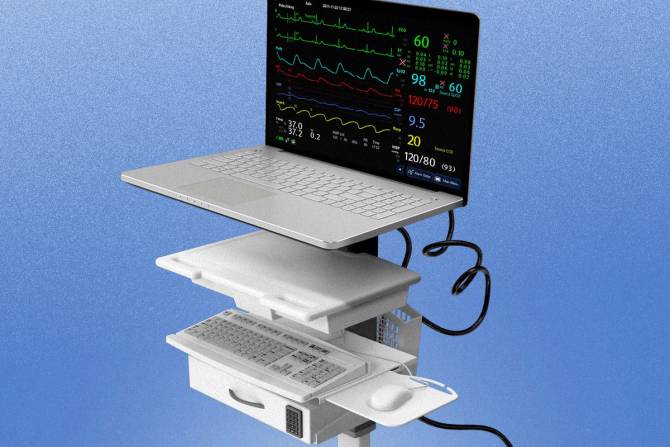Happy Monday! Our intrepid reporter, Maia Anderson, has been digging into Elixir, Rite Aid’s pharmacy benefit manager, or PBM. Rite Aid, which bought the PBM in 2015, has been hit with a class-action lawsuit for allegedly inflating the number of members Elixir has. She’s itching to talk with staffers—both former and current—who could give us insight into Elixir’s business. Hit Maia up.
In today’s edition:
 Elixir lawsuit Elixir lawsuit
 Infectious diseases Infectious diseases
 Domestic manufacturing Domestic manufacturing
—Maia Anderson
|
|
Ja_inter/Getty Images
When Rite Aid dropped roughly $2 billion in 2015 to buy its pharmacy benefit management (PBM) subsidiary now known as Elixir, the company had framed the investment as a strategic move to compete in the healthcare marketplace among rivals like CVS and Walgreens.
The deal quickly helped make Rite Aid $4.1 billion in its newly formed pharmacy services segment—including Elixir and other pharmacy services, according to the company—bolstering its financial standing the next fiscal year. Maybe it would no longer be the ugly duckling next to the cooler, sleeker swans.
It seemed to be working—for a while at least. But by 2018, analysts were recommending Rite Aid sell off Elixir to reduce the parent company’s debt. Still, Rite Aid stuck with Elixir in hopes of boosting its competitiveness in the retail pharmacy scene.
This year, Rite Aid President and CEO Heyward Donigan was still painting a rosy picture of Elixir, saying in earnings calls that the PBM was gaining more members and Elixir’s operating margins were improving.
But a month after its latest earnings call in September, Rite Aid was hit with a class-action lawsuit accusing the company of making “false and/or misleading statements” to investors about Elixir’s status between April and September of this year.
Here’s the breakdown. Several firms specializing in securities class-action cases filed the lawsuit against Rite Aid on Oct. 19, which claims the company made “materially false and misleading statements” between April 14 and Sept. 28, 2022. The suit is open to anyone (besides the defendants) who purchased Rite Aid securities between those dates. Keep reading here.—MA
Do you work in healthcare or have information about the industry that we should know? Email Maia at [email protected]. For completely confidential conversations, ask Maia for her number on Signal.
|
|
|
Finding time for 1-on-1s with the head honchos isn’t easy. Those folks are straight-up busy, especially in the chaotic world of health tech. But getting to know your colleagues is essential to succeeding at work—and enjoying the time you spend there.
Fortunately, connectRN understands the significance of a meet and greet. Their new blog post, “5 Questions with connectRN CEO, Ted Jeanloz,” offers a humanizing window into the C-suite state of mind.
In this sit-down convo, Jeanloz discusses his background, gives his thoughts on the current state of healthcare, and reveals what it's like being CEO of a hyper-growth company while also trying to change a profound problem.
Get to know Ted Jeanloz here.
|
|
Luis Alvarez/Getty Images
Covid and RSV and flu (and mpox and polio and Ebola), oh my!
Not only is the “tripledemic” threat of Covid, respiratory syncytial virus (RSV), and the flu looming over health systems this winter, but cases of monkeypox (mpox) and polio are also popping up in some parts of the country.
In addition, National Nurses United, the largest nurses union in the US, started circulating a letter in early October demanding health systems share information on their care plans for patients with Ebola. The letter came in response to an Oct. 6 health alert from the US government ordering airlines to screen passengers arriving from Uganda for the virus.
With all these diseases circulating simultaneously, US health systems face a potential massive wave of hospitalizations this winter. And while most businesses expect more customers will improve their profit margins, that’s not always the case with health systems.
More viral illnesses means less time for profitable procedures. The amount of revenue a health system brings in varies widely depending on the type of service being offered, according to Matthew Weiss, managing director of EY-Parthenon’s healthcare strategy business. Elective surgeries bring in more money than treating Covid or the flu, but when there’s a surge of viral illnesses, there are fewer beds for those profitable procedures.
How to prepare for a big winter surge. “It’s difficult to give a recommendation that would immediately solve the problem” for how hospitals can prepare for a potential “onslaught” of hospitalizations this winter, said Jay Varma, an epidemiologist and professor at Weill Cornell Medical College.
But one thing hospitals can do is make sure they have an emergency response system, which starts with gathering data about outbreak threats in their community, he said. Keep reading here.—MA
|
|
Andriy Onufriyenko/Getty Images
In the early days of the pandemic, there were shortages of seemingly everything from toilet paper to glass jars (obviously for your sourdough starter kits). One of the more serious shortages we’re still seeing nearly three years later is pharmaceuticals.
A big reason for this is that the US relies on other countries—mainly India and China—to manufacture the main ingredients for drugs, called active pharmaceutical ingredients, or APIs. A 2019 FDA study found that 72% of the facilities that supply the US with APIs are overseas because it’s simply cheaper to make them there.
India relies on China for manufacturing materials, and when the pandemic started, the country experienced supply chain delays. In response, the Indian government restricted exports of APIs to prevent shortages in its country, leading to shortages in the US.
Having enough manufacturing capacity to make drugs domestically and avoid relying on other countries would go a long way to prevent drug shortages, which cost hospitals an estimated $360 million every year.
And yet, nearly 30% of American manufacturing sites are operating at—or below—50% capacity, according to a study from Washington University in St. Louis. Of the remaining sites, about 35% are operating between 50%–80% capacity and about 30% are operating over 80% capacity. Slightly more than 5% are operating near full capacity, the study found. Lynne Byers, global managing director of pharmaceuticals and dietary supplements consulting at NSF, a public health and safety organization, said the sites writ large aren’t operating at 100% because they just don’t have the demand.
But if all of the sites got their capacities up to 100%, nearly 30 billion more doses of medicines could be made in the US without having to build new manufacturing plants, according to the Washington University study.—MA
|
|
|
Get to know the CEO. It’s not every day that C-suite execs have time to discuss their thoughts, especially in the busy world of nursing. But connectRN found time. They talked with CEO Ted Jeanloz about his background, the state of healthcare, and what it’s like leading a fast-growing company set on changing a profound problem. Read the Q&A here.
|
|
Francis Scialabba
Today’s top healthcare reads.
Stat: New York Gov. Kathy Hochul has about $2 billion to allocate for programs helping those with opioid use disorder, but wants to exclude overdose prevention centers from receiving funding. (Gothamist)
Quote: “But didn’t we test for that? That was kind of where the lightbulb clicked.”—Amanda, a science researcher who declined to share her last name, on the death of her newborn daughter due to a fatal genetic disorder (ProPublica)
Read: Did the Dobbs ruling spark a national surge in vasectomies? (Politico)
|
|
Catch up on the top Healthcare Brew stories you may have missed:
|
|
|
Written by
Maia Anderson
Was this email forwarded to you? Sign up
here.
WANT MORE BREW?
{if !contains(profile.lists,"Daily Business")}
Get the daily email that makes reading the news enjoyable →
{/if}
{if !contains(profile.lists,"EmTech Brew") || !contains(profile.lists,"HR Brew") || !contains(profile.lists,"Marketing Brew") || !contains(profile.lists,"Retail Brew") || !contains(profile.lists,"IT Brew") || !contains(profile.lists,"Future Social") || !contains(profile.lists,"CFO Brew")}
Industry news, with a sense of humor →
{if !contains(profile.lists,"CFO Brew")}
-
CFO Brew: your go-to source for global finance insights
{/if}
{if !contains(profile.lists,"EmTech Brew")}
-
Emerging Tech Brew: AI, crypto, space, autonomous vehicles, and more
{/if}
{if !contains(profile.lists,"Future Social")}
-
Future Social: the Brew's take on the world of social media
{/if}
{if !contains(profile.lists,"HR Brew")}
-
HR Brew: analysis of the employee-employer relationship
{/if}
{if !contains(profile.lists,"IT Brew")}
-
IT Brew: moving business forward; innovation analysis for the CTO, CIO & every IT pro in-between
{/if}
{if !contains(profile.lists,"Marketing Brew")}
-
Marketing Brew: the buzziest happenings in marketing and advertising
{/if}
{if !contains(profile.lists,"Retail Brew")}
-
Retail Brew: retail trends from DTC to "buy now, pay later"
{/if}
{/if}
{if !contains(profile.lists,"Money Scoop") || !contains(profile.lists,"The Essentials") || !contains(profile.lists,"Money With Katie")}
Tips for smarter living →
{if !contains(profile.lists,"Incrypto")}
-
Incrypto: Finally, crypto news you can understand
{/if}
{if !contains(profile.lists,"Money Scoop")}
-
Money Scoop: your personal finance upgrade
{/if}
{if !contains(profile.lists,"Money With Katie")}
-
Money With Katie: manifest your financial freedom
{/if}
{if !contains(profile.lists,"The Essentials")}
-
Sidekick: lifestyle recs from every corner of the internet
{/if}
{/if}
 Podcasts →
Business Casual,
Founder's Journal,
Imposters, and
The Money with Katie Show
Podcasts →
Business Casual,
Founder's Journal,
Imposters, and
The Money with Katie Show
 YouTube
YouTube
Accelerate Your Career with our Courses →
|
ADVERTISE
//
CAREERS
//
SHOP
//
FAQ
Update your email preferences or unsubscribe
here.
View our privacy policy
here.
Copyright ©
2022
Morning Brew. All rights reserved.
22 W 19th St, 4th Floor, New York, NY 10011
|
|









